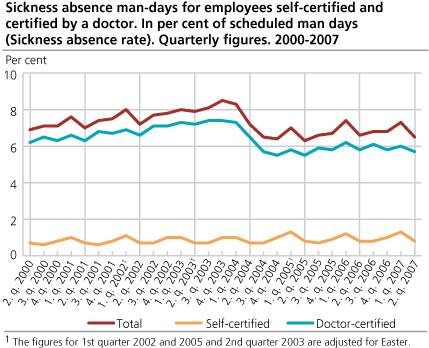Content
Published:
This is an archived release.
A small decrease in the sickness absence
The sickness absence dropped from 6.6 per cent in the second quarter of 2006 to 6.5 per cent in the second quarter of 2007. This correspond to a decrease of 2.7 per cent.
Absence certified by a doctor decreased a from 5.8 to 5.7 per cent, while the self-certified absence remained stable, at 0.8 per cent. For men the sickness absence dropped by 3.9 per cent, and for women it dropped by 1.5 per cent.
The sickness absence in the second quarter of 2007 was 7.6 per cent lower than in the second quarter of 2001, the year when the agreement on an inclusive labour market was implemented.
Decrease in almost all of the industry divisions
Amongst the larger industries, the decrease in sickness absence was largest in public administration with 4.8 per cent and transport and communication with 4.7 per cent. Financial intermediation were the only industry which had approximately unchanged sickness absence. On the other hand, this is the industry with the lowest level.
A stable proportion of long-lasting absences
The proportion of doctor certified sickness absence lasting more than 31 days within this quarter, remained unchanged with 63.5 per cent from the second quarter of 2006 to the second quarter of 2007. The proportion of self-certified sickness absence compared to the total sickness absence (self-certified and doctor-certified) also remained unchanged with 11.6 per cent.
Decrease in all of the sectors
The sickness absence in the private sector had the largest fall with 2.9 per cent, followed by local government with a decrease by 2.4 per cent. In the central government sector (including the state hospitals), the sickness absence declined by 1.4 per cent.
Within the central government sector, the sickness absence for the public administration industry dropped the most by 2.7 per cent. In the education industry (universities and colleges), it decreased by 1.9 per cent and the health-care industry (mainly the state hospitals) by 0.7 per cent. Within local government, the public administration industry had the strongest fall by 6.3 per cent.
Local government had the highest level of the sickness absence with 9.2 per cent, while private sector had the lowest in with 6 per cent
Decline in most of the age groups
Within the largest age group 16-66 years, the doctor certified sickness absence increased the most in the age group 20-24 years by 3.2 percent and in the age groups 30-34 years by 0.4 per cent. Otherwise the sickness absence decreased. The age group 60-64 years had the largest decrease by 4.0 per cent.
Females had the strongest decrease in the age group 55-59 years by 4.6 per cent and for males the age group 50-54 years had the largest fall by 5.5 per cent.
Continued decline in most of the age groups
With the exception of the age groups 16-24 years, the doctor certified sickness absence decreased. Within the largest age groups, the 55-59 years had the strongest decline by 5.8 per cent and the 60-64 years decreased by 4.9 per cent.
Females had the strongest decrease in the age group 55-59 years by 5.6 per cent and for males the age group 35-39 years had the largest fall by 5.5 per cent.
The results are based on data on sickness absence certified by a doctor, as the survey on self-certified absence does not contain data on sickness absence by age.
The sickness absence rate measures the proportion of scheduled man-days lost due to own sickness. The statistics do not cover self-employed persons.
Tables:
- Table 1 Sickness absence man-days for employees self-certified and certified by a doctor. In per cent of scheduled man-days (Sickness absence rate). Quarterly figures. 2000-2007
- Table 2 Sickness absence man-days for employees self-certified and certified by a doctor, by sex. In per cent of scheduled man-days (Sickness absence rate). Quarterly figures. 2000-2007
- Table 3 Sickness absence man-days for employees self-certified and certified by a doctor, by industry and type of sickness absence. In per cent of scheduled man days (Sickness absence rate). Quarterly figures. 2000-2007
- Table 28 Sickness absence by type of absence(self-certified or doctor-certified) and duration within the quarter
- Table 33 Change in per cent of the sickness absence rate for employees self-certified and certified by a doctor, by industry and type of sickness absence. Quarterly changes. 2000-2007
Contact
-
Arbeidsmarked og lønn
E-mail: arbeidsmarked@ssb.no
-
Unn H. Høydahl
E-mail: unnh.hoydahl@ssb.no
tel.: (+47) 40 90 23 77

